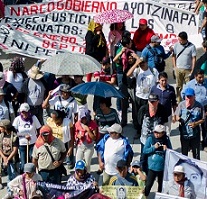
Since the forced disappearance in Iguala, Guerrero, of 43 Normalista students from the Ayotzinapa Rural Teachers College on September 26, 2014, hundreds of thousands of people have taken to the streets to demand that the students be returned alive and also to denounce political corruption and the “Narco-Government.” The Southern state of Guerrero has been the epicenter of these protests and a wide range of actions including citizen searches, takeovers of tollbooths, a statewide caravan and the burning of government buildings.
Mexico has not been the same since the forced disappearance in Iguala, Guerrero of 43 Normalista students from the Ayotzinapa Rural Teachers College on September 26, 2014. Hundreds of thousands of people have taken to the streets to demand that the students be returned alive and also to denounce political corruption and the “Narco-Government.” The Southern state of Guerrero has been the epicenter of these protests and a wide range of actions including citizen searches, takeovers of tollbooths, a statewide caravan, the burning of government buildings, and more.
![]()
Since the disappearance of 43 students from the Raul Isidro Burgos Ayotzinapa School and the extrajudicial killing of 3 students, Julio Cesar Ramirez Nava, Daniel Solis Gallardo and Julio Cesar Mondragon at the hands of the police, students have suspended classes.
![]()
With photos of their missing children in hand, family members of the Ayotzinapa students marched in Acapulco a little over one month after the disappearance of their children. The involvement of municipal police in the attack has led the phrases “It was the state” and “narco-state” to become popular vernacular.
![]()
As a way to raise awareness and funds for their activities in search of their missing classmates, Normalista students often take over tollbooths, collecting donations from passing drivers. The government has cut off their already meager food rations since the attack, leading them to rely on donations.
![]()
Ayotzinapa students are part of the Federation of Socialist Campesino Students (FECSM), composed of 16 schools, of which six are all female. Hundreds of these young women have travelled to Ayotzinapa to participate in the movement. Here they assist with a tollboth takeover near the Guerrero capital of Chilpancingo.
![]()
People across the world have demonstrated their solidarity with Ayotzinapa, and here these actions are shown in photos hung on the school’s basketball court, which has become the central gathering point for the family members of the disappeared.
![]()
Nativita, the mother of missing student Emiliano Allen Gaspar de la Cruz proudly shows off an ingenious invention of her son, in their humble home in Omeapa, Guerrero.
![]()
Due to their militant actions in defense of public education, the Normalista students are often criminalized in the media and called vandals. To break with this stereotype and show their true desire to be elementary school teachers, they participated in a clown performance in the town of Tixtla, Guerrero.
![]()
This is the garbage dump in Cocula, Guerrero where the Attorney General Jesus Murillo Karam says that cartel members massacred and burned the students the night of the attack in Iguala. Various scientists, journalists and activists have debunked this theory saying the government is using it as an attempt to bury the case. An independent Argentinian forensic team identified the remains in a bag of ashes as belonging to one of the students Alexander Mora Venancio, but have stated that this still does not give credibility to the governments claims, as they were not present during the discovery of the bag.
![]()
“People can die, but not their ideas” reads a mural in the town of Tixtla, located next to the Ayotzinapa school. Art has played a key role in the movement for the 43 students.
![]()
The CETEG [Coordinadora Estatal de los Trabajadores de la Educación de Guerrero], the Guerrero Teachers Union, has played an active role in the movement for justice for Ayotzinapa. They erected an encampment in the center of the Guerrero capital, Chilpancingo and have participated in various militant actions including setting fire to the Municipal Palace as well as various other government buildings.
![]()
Across Guerrero, teachers and ordinary residents have taken over city halls denouncing corrupt governments and the extraordinary numbers of disappeared people. Here in San Luis Acatlan, home to the CRAC, the Regional Coordinating Body of Community Authorities of the Mountain and Costa Chica of Guerrero, a community police force, the townspeople welcomed a caravan of students and family members from Ayotzinapa.
![]()
Family members marched in the town of Ayutla, Guerrero, home of 4 of the disappeared students, and a fifth, Aldo Gutiérrez Solano, who is in a coma after he received a bullet in the head the night of the attack.
![]()
A cousin of an Ayotzinapa student welcomes the caravan with a sign that reads “[We] the children of the world demand peace and justice for the 43 disappeared [students].”
![]()
On December 12th, 2014, a few thousand people marched on the highway in Chilpancingo to commemorate the 2011 assassination of two Ayotzinapa students, Jorge Alexis Herrera Pino y Gabriel Echeverría de Jesús, who were killed by police when they protested for reforms and an improved school budget.
![]()
During a highway blockade at the site of the 2011 assassination, students set fire to puppets of politician, demonstrating their disgust with local, state and federal government officials.
![]()
Without their children present, family members said they would not celebrate Christmas or the New Year and instead marched on President Peña-Nieto’s home in Mexico City. On the basketball court in Ayotzinapa, they erected a Xmas tree with messages for the 43 students alongside their school desks.
Andalusia Knoll is a freelance multimedia journalist based in Mexico City. In addition to Upside Down World, she is a frequent contributor to VICE News, AJ+, Democracy Now! and Truthout. In Mexico, she collaborates with various independent media and art collectives. You can follow her on twitter @andalalucha.
